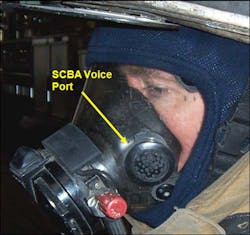Clear and concise radio transmissions are an essential component of every fireground operation. They are necessary in order to ensure the safety of all members operating at an incident. Garbled and unintelligible messages can prevent incident commanders from receiving important or even critical information that is needed to make the proper decisions while conducting the operation. Since switching to the 800 MHz digital radio system several years ago, the Washington, D.C. Fire Department (DCFD) has experienced an increase in problems with radio transmission intelligibility on the fireground.
Intelligibility problems, such as these have also occurred quite often while conducting training evolutions. We recently conducted department-wide rapid intervention drills as a part of our ongoing "back to basics," in-service training. Many of the radio transmissions made during these drills were difficult to hear and understand due to low voice volume, or were completely unintelligible due to background noise. It was later discovered that some of these unintelligible transmissions could be directly attributed to a combination of members positioning the remote speaker microphone too far from the self-contained breathing apparatus (SCBA) face piece voice port (see Photo 1) as well as the presence of excessive fireground background noise during the transmission.
This problem is not limited to our department by any means. In 2006, the International Association of Fire Chiefs (IAFC) began receiving reports of possible communications problems involving digital portable radios that were operating in close proximity to common fireground noises such as SCBA low air alarms, PASS devices, power saws and fans. Because of this, the IAFC has established a committee to look into this issue. The committee is composed of representatives from the fire service, law enforcement, government as well as the radio system manufacturers.
As a result of their research into this issue, the IAFC committee has come up with a set of best practices for operating portable radios in a high-noise environment:
- When calling a Mayday, always make the radio transmission before activating your PASS device. This is because the noise from the PASS device may cause the message to be unintelligible.
- Position the remote speaker microphone one to two inches away from the SCBA face piece voice port or speaker diaphragm (see Photo 2) and angle the microphone so that you are speaking directly into it and not across it.
- Speak in a loud, clear and controlled voice (this will dramatically improve radio performance in all situations, but especially in those with a noisy environment).
- Try to shield the microphone from noise sources by cupping your hand around the back of the mic.
- Use a free hand to muffle the low air alarm on the mask-mounted regulator if you are transmitting during a low air event. Covering the regulator can greatly improve radio intelligibility in this situation.
- Locate radios and microphones as far as possible from PASS devise and other equipment that generate noise.
In addition to the best practices recommended by the IAFC, Motorola, the manufacturer of many 800 MHz portable radio models, has the following recommendation:
- Users who are wearing SCBA masks should hold the speaker-microphone directly over and flush with (flat against) the SCBA voice port or speaker diaphragm (see Photo 3.)
While conducting unofficial tests of these best practice recommendations, members of the DCFD have come to find that a combination of some of the practices recommended by the IAFC as well as the recommendations put forth by Motorola seems to be the most effective in improving radio transmission intelligibility.
Members have determined that by simply placing the speaker-mic flat against the SCBA voice port (as recommended by Motorola) while cupping the back side of the mic (as recommended by the IAFC), radio transmissions can usually be heard much more clearly during normal operations, as well as high noise environments (see Photos 3 and 5). Using the mic in this manner allows for a more intelligible transmission and can effectively block out much of the background noise.
Many of firefighters wear their portable radios on the outside of their PPE, utilizing a carrying case and shoulder strap. When worn in this fashion, the mic is usually attached to the tab on the shoulder strap. This makes it difficult to place the mic in direct contact with the voice port on the facepiece in order to make a transmission. Detaching the mic from the tab is difficult with a gloved hand, and is not practical every time a transmission is to be made.
However, there are some retractable speaker-mic lanyards that are available that make this both possible and practical. These devices can be clipped onto the mic tab on the radio shoulder strap (see Photo 4). The retractable end of the device is attached to the clip on the back of the speaker mic as shown in Photo 6. This allows the mic to be placed in contact with the voice port to make a transmission without having to detach it from the shoulder strap (see Photo 5). When the transmission is completed, the user simply lets go of the mike, allowing it to retract back to its original position. A pin-able version of these devices are available, and can be utilized in the same manner if the radio is carried in the in a radio pocket or worn under the coat, as many firefighters prefer (see Photos 6 and 7). These devices are available for approximately $20.00.
This article should not be considered as an official endorsement any of the products or practices presented here. The intent is merely to present firefighters with as much information as possible in order to assist them in improving their safety while operating on the fireground.
DANIEL TROXELL, a 32-year veteran of the fire service, is the captain of Truck Company 6 in the Washington, D.C. Fire Department. He is a Pro Board Certified Level III Instructor and serves as an adjunct instructor with the DCFD Training Academy, and has developed and instructed courses for in-service training as well as for probationary firefighter training. He holds a bachelor of science degree in fire protection engineering and a master of science degree in applied management, both from the University of Maryland.






